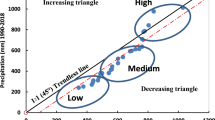Abstract
PMP has two different estimation methods, namely statistical and hydro-meteorological approaches. The statistical method is based on the calculation of frequency factor (FF) by taking into account the arithmetic mean and standard deviation parameters. The classical probable maximum precipitation (PMP) is based on the (FF) calculated from the annual daily maximum precipitation (ADMP) time series records, which excludes the maximum recording. The classical method returns an FF value without any uncertainty. This paper suggests a successive FF (SFF) method that leads to a series of SFFs, starting with the first three records, and then scanning the entire time series. The probabilistic operation of the SFF sequence presents the uncertainty components in FF based on a set of preset exceedence probability levels and their corresponding return periods. The application of the methodology is presented for three ADMP records from Turkey, Algeria and Arabian Peninsula, which represent humid, semi-arid and arid regions, respectively. The arithmetic mean of the SSF values for the meteorology stations in each country was calculated as 3.07, 2.75 and 3.45, respectively. However, predetermined exceedence probability amounts are presented in the form of tables and graphics. It was concluded that the classical FF calculation provides a single value without any exceedence probability assessment, whereas the SFF method provides FF values with a range of exceedence probability levels.








Similar content being viewed by others
Data availability
The data and Matlab code are available from the author upon reasonable request.
References
Benson MA (1973) Thoughts on the design of design floods. In: Shultz EF, Koelzer VA, Mahmood K (eds) Floods and droughts. Water Resources Publications, Fort Collins, Colorado, pp 27–33
Dawdy DR, Lettenmaier DP (1987) Initiative for risk-based flood design. ASCE J Hydraul Eng 113(8):1041–1051
Douglas EM, Barros AP (2003) Probable maximum precipitation estimation using multifractals: application in the Eastern United States. J Hydrometeorol 4:1012–1024
Hershfield DM (1961) Estimating the probable maximum precipitation. J Hydraul Div Am Soc Civ Eng 87:99–106
Hershfield DM (1965) Method for estimating probable maximum precipitation. Am Water Works Assoc 57(8):965–972
Kite GW (1977) Frequency and risk analysis in hydrology. Water Resources Publications, Littleton
Koutsoyiannis D (1999) A probabilistic view of Hershfield’s method for estimating probable maximum precipitation. Water Resour Res 35(4):1313–1322
Koutsoyiannis D (2004) Statistics of extreme and estimation of extreme precipitation II: empirical investigation of long precipitation records. Hydrol Sci J 49(4):591–610
Koutsoyiannis D, Papalexiou SS (2006) A probabilistic approach to the concept of probable maximum precipitation. Adv Geosci 7:51–54
Kulkarni BD (2010) Generalized physical approach of estimating areal probable maximum precipitation for plain region of the Godavari River Basin (India). J Spat Hydrol 2:2
Kundzewicz ZW, Radziejewski M, Pińskwar I (2006) Precipitation extremes in the changing climate of Europe. Clim Res 31:51–58
Lee K, Singh VP (2020) Analysis of uncertainty and non-stationarity in probable maximum precipitation in Brazos River basin. J Hydrol 590:125526
Mamoon AA, Rahman A (2014) Uncertainty in design rainfall estimation: a review. J Hydrol Environ Res 2(1):65–75
Micovic Z, Schaefer MG, Taylor GH (2014) Uncertainty analysis for probable maximum precipitation estimates. J Hydrol 521:360–373
Salas JD, Gavilán G, Salas FR, Julien PY, Abdullah J (2014) Uncertainty of the PMP and PMF. Handbook of Engineering Hydrology, Chapter 28. Taylor and Francis Group, LLC, pp 577–599
Singh A, Singh VP, Byrd AR (2018) Computation of probable maximum precipitation and its uncertainty. Int J Hydrol 2(4):504–514
Tetzlaff G, Zimmer J (2013) Probable Maximum Precipitation (PMP). In: Bobrowsky PT (ed) Encyclopedia of natural hazards. Encyclopedia of earth sciences series. Springer, Dordrecht. https://doi.org/10.1007/978-1-4020-4399-4_277
World Meteorological Organization (1986) Manual for estimation of probable maximum precipitation, 2nd edn. Operational Hydrology Report No. 1, WMO-No. 332, Geneva
World Meteorological Organization (2009) Manual on estimation of probable maximum precipitation+. WMO-No.1045, Geneva, Switzerland
Zhang Y, Singh VP, Byrd AR (2019) Basin-scale statistical method for probable maximum precipitation with uncertainty analysis. J Hydrol Eng 24(2):04018067
Author information
Authors and Affiliations
Corresponding author
Ethics declarations
Conflict of interest
The author declare that they have no conflict of interest.
Ethical approval
I read the ethical codes and my article complies with all the items without any problem.
Additional information
Responsible Editor: Clemens Simmer.
Publisher's Note
Springer Nature remains neutral with regard to jurisdictional claims in published maps and institutional affiliations.
Rights and permissions
Springer Nature or its licensor holds exclusive rights to this article under a publishing agreement with the author(s) or other rightsholder(s); author self-archiving of the accepted manuscript version of this article is solely governed by the terms of such publishing agreement and applicable law.
About this article
Cite this article
Şen, Z. Successive probable maximum precipitation (SPMP) methodology and applications. Meteorol Atmos Phys 134, 94 (2022). https://doi.org/10.1007/s00703-022-00928-z
Received:
Accepted:
Published:
DOI: https://doi.org/10.1007/s00703-022-00928-z




